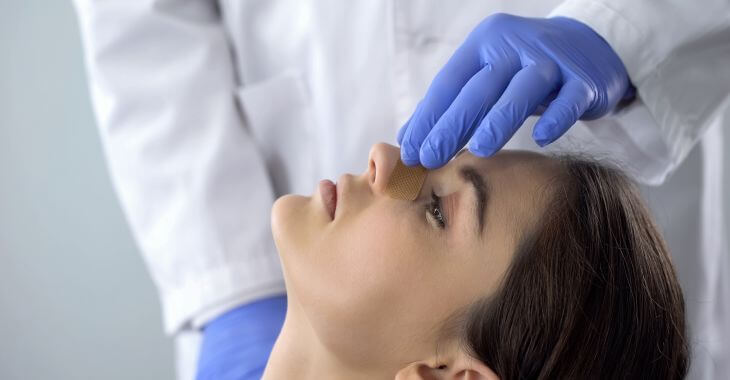Understanding the Rhinoplasty Recovery Timeline

Rhinoplasty, commonly known as a nose job, is a surgical procedure designed to reshape or resize the nose for aesthetic or functional purposes. Understanding the rhinoplasty recovery timeline is essential for managing expectations and ensuring a smooth and successful recovery.
Whether you are seeking to correct a nasal hump, refine the nasal tip or improve breathing difficulties, rhinoplasty can achieve dramatic results and enhance facial harmony. However, undergoing rhinoplasty is a significant decision that requires careful consideration of the recovery process.
In this article, we will discuss the various phases and stages of nose job recovery and what you can expect with rhinoplasty recovery time.
Immediate Post-Operative Period (Days 1-7)
The immediate post-operative period following rhinoplasty is characterized by swelling, bruising and discomfort. Immediately after surgery, your nose will be bandaged, and you may have internal nasal splints or packing to support the newly sculpted nasal structures.
It is normal to experience congestion, nasal drainage, and mild discomfort during this time. Pain medication prescribed by your surgeon can help alleviate any discomfort, and it is essential to follow your surgeon’s post-operative instructions carefully.
During the first week of recovery, it is crucial to rest and avoid strenuous activities to allow your body to heal properly. Elevating your head with pillows while sleeping can help minimize swelling and promote drainage.
Your surgeon may remove any external splints or bandages during a follow-up appointment within the first week or two after surgery. Internal nasal splints or packing are typically removed within the first week, which can provide significant relief from nasal congestion.
You should also avoid blowing your nose or engaging in activities that could put pressure on your nose, such as bending over or lifting heavy objects.
Subacute Recovery Phase (Weeks 2-4)
As the initial swelling and bruising begin to subside, you will start to notice gradual improvements in the appearance of your nose during the subacute recovery phase. While some swelling and bruising may persist, most patients feel comfortable returning to work or social activities within two weeks.
To prevent complications and promote optimal healing, it is essential to continue avoiding strenuous activities, including exercise, heavy lifting and contact sports. You may also begin using saline nasal spray or irrigation to keep the nasal passages moist and promote healing.
Early Recovery Phase (Weeks 4-8)
By the fourth week after surgery, most of the initial swelling and bruising will have subsided, and you will start to see more noticeable improvements in the appearance of your nose. While you may still experience minor swelling, your nose will begin to take on its final shape in the early recovery phase.
It is essential to continue following your surgeon’s post-operative instructions and attending any scheduled follow-up appointments. Your surgeon will monitor your progress, assess the healing process, and provide guidance on gradually resuming normal activities, including exercise and sports.
Intermediate Recovery Phase (Months 2-6)
The intermediate recovery phase, which spans from two to six months after surgery, is characterized by further refinement of the nasal contour and resolution of any residual swelling. While the majority of swelling is gone by this point, subtle changes in shape may continue to occur as tissues settle and heal.
By the end of the intermediate recovery phase, you will likely be enjoying the final results of your rhinoplasty, with a more balanced and harmonious nasal appearance. It is important to continue attending follow-up appointments with your surgeon to ensure that the healing process is progressing.
Long-Term Recovery and Final Results (Months 6-12+)
The long-term recovery phase encompasses the period from six months to one year or more after surgery, during which the final results of your rhinoplasty become fully apparent. This is when the true outcome of the surgery is achieved.
While the majority of swelling will have subsided by this point, minor residual swelling may persist, particularly in the nasal tip area. However, the overall appearance of your nose will continue to refine and improve as the tissues fully heal and settle into place, resulting in the desired outcome.
By the end of the long-term recovery phase, you will enjoy the full benefits of your rhinoplasty with a more balanced, proportionate and aesthetically pleasing nasal contour. It is essential to continue practicing sun protection to maintain the health and appearance of your nose over the long term.

Understanding the rhinoplasty recovery timeline is essential for managing expectations and ensuring a smooth and successful recovery process. While every patient’s recovery experience is unique, following your surgeon’s post-operative instructions and attending scheduled follow-up appointments are critical.
Rhinoplasty recovery time may seem extensive, but most patients agree it is worth the effort to obtain the results. By taking the time to care for yourself during each stage of recovery, you can enjoy the transformative benefits of rhinoplasty and achieve the nose you have always desired.
The information provided on this website, including text, graphics, images, and other materials, is intended solely for informational purposes and should not be used as a substitute for professional medical advice, diagnosis, or treatment.




)